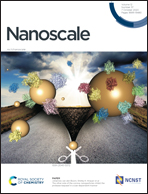Red-emitting GSH-Cu NCs as a triplet induced quenched fluorescent probe for fast detection of thiol pollutants†
Abstract
Thiol compounds exist widely on the Earth and have certain significance in the fields of the circulation of the sulfur element and industrial production. However, the odor and biological toxicity of thiol compounds make them pollutants that seriously threaten the environmental safety and the living quality of human. In this study, a novel triplet induced fluorescence “turn-off” strategy was designed for the detection of thiol pollutants via a glutathione-stabilized copper nanocluster (GSH-Cu NC) probe. The as-prepared GSH-Cu NCs not only have small size and good water-solubility, but also exhibit strong red-emitting fluorescence at 630 nm, which could be quenched quantitatively with the increase of the concentration of thiol pollutants. So they were employed to detect thioglycolic acid (TGA), 3-mercaptopropionic acid (MPA), 2-mercaptoethanol (ME) and 2-(diethylamino)ethanethiol (2-AT) in a wide linear range of 1–100 μM with detection limits of 0.73 μM, 0.43 μM, 0.37 μM, and 0.69 μM, respectively. This method was successfully applied to detect the above thiol pollutants in lake water with good recoveries. Moreover, their further application was also expanded as luminous test strips based on the excellent fluorescence characteristics of GSH-Cu NCs for fast real-time detection of thiol pollutants.



 Please wait while we load your content...
Please wait while we load your content...